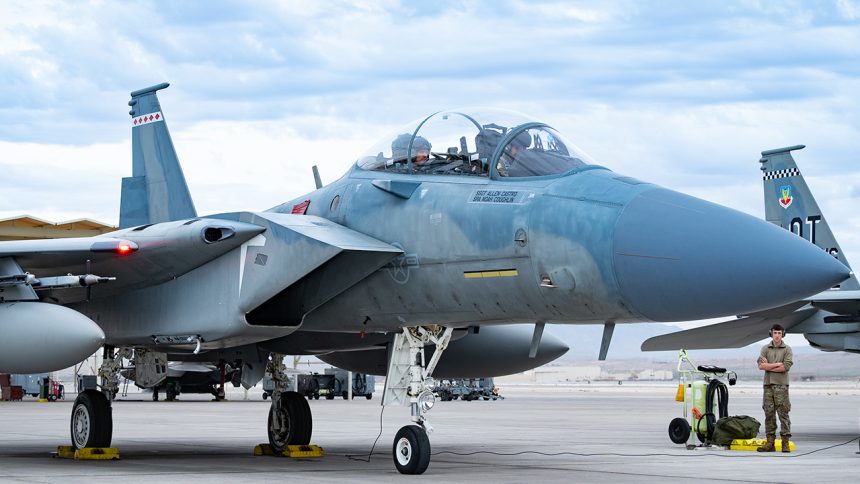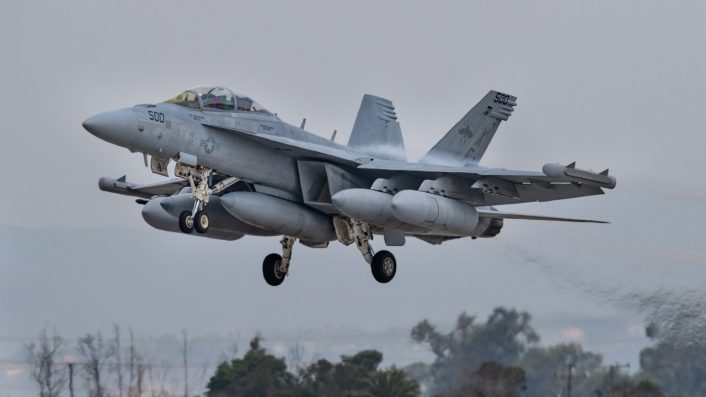The new “Wild Weasel” variant of the F-15EX would make use of both existing capabilities of the aircraft, as well as new ones integrated from the Growler.
As the production line of the F/A-18 is about to close, Boeing is studying whether the F-15EX Eagle II can be equipped to become the successor of the EA-18G Growler. The new “Wild Weasel” variant of the F-15EX would make use of both existing capabilities of the aircraft, as well as new ones integrated from the Growler.
“We are evaluating the technical feasibility of combining EA-18G-like capabilities with the F-15EX platform,” said Rob Novotny, Boeing’s executive director for Fighters Business Development. Novotny added that the study is still in the initial stage, but the company is already eyeing opportunities both for NATO members and the Indo-Pacific.
The move is due to the planned stop to the production of the F/A-18E/F Super Hornet in 2027, which in turn means the production of the EA-18G Growler will also end. On the other hand, the production of the Advanced Eagle is expected to continue for many years and leaves the door open to a new specialized variant for Electronic Warfare (EW).
“Modern aerial combat requires command of the electromagnetic spectrum, and this platform would lead the way into the next decade or two,” Novotny said. He also pointed out that the Eagle II offers several design advantages, including the aircraft’s range, speed, computing power and payload capacity.
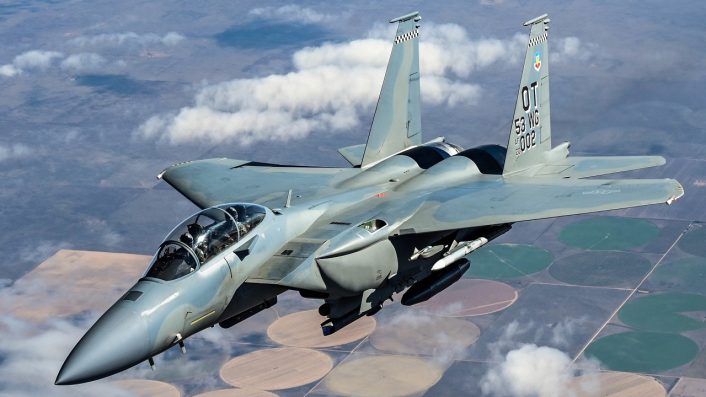
One could argue that a low-observable, or stealth, aircraft like the F-35 could be better suited for the job, however Novotny mentioned that stealth shouldn’t be understood strictly in terms of low-observable coatings. In fact, similarly to the Growler, such capabilities could be also replicated by using advanced EW functions.
“Stealth means, to me, I can go to a place where the enemy doesn’t want me to go, and I can operate in their environment, achieve my objective, and not be targeted,” said Novotny.
The F-15EX is already equipped with advanced EW capabilities thanks to the Eagle Passive Active Warning Survivability System (EPAWSS), but it also has the ability to carry the AGM-88 High-Speed Anti-Radiation Missiles (HARMs). In addition to these, Boeing is exploring also the possibility to integrate the AGM-88G Advanced Anti-Radiation Guided Missile-Extended Range (AARGM-ER) and the Next Generation Jammer (NGJ) pods. Still, there’s no naval variant of the Eagle II, therefore, it looks like such a successor of the EA-18G could not operate from the flight deck of an aircraft carrier unlike the Growler.
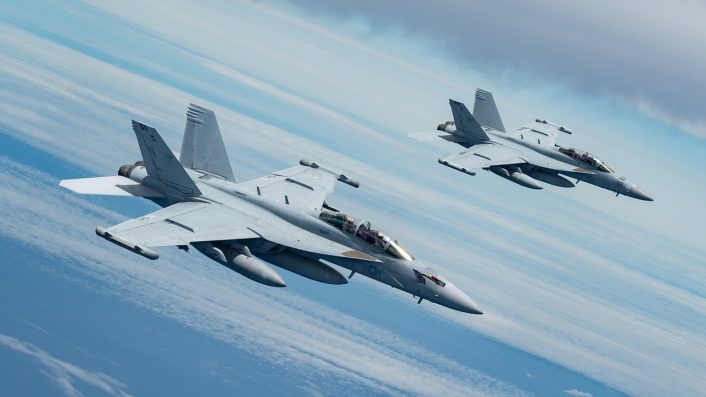
The F-15EX and the existing EW capabilities
The new F-15EX, developed from the F-15QA that was the most advanced Eagle variant, comes from a series of needs mainly emerged after the National Defense Strategy directed the U.S. armed services to adapt to the new threats from China and Russia. The aircraft, while extremely similar to the QA variant, features some US-only capabilities like the new AN/ALQ-250 Eagle Passive Active Warning Survivability System (EPAWSS) electronic warfare and electronic surveillance system and Open Mission Systems (OMS) architecture.
The F-15EX’s systems are powered by the Advanced Display Core Processor II, reportedly the fastest mission computer ever installed on a fighter jet, and the Operational Flight Program Suite 9.1X, a customized variant of the Suite 9 used on the F-15C and F-15E, designed to ensure full interoperability of the new aircraft with the “legacy Eagles”.
The F-15EX is equipped with the AN/APG-82(V)1 Active Electronically Scanned Array (AESA) radar, developed from the APG-63(V)3 AESA radar of the F-15C and the APG-79 AESA radar of the F/A-18E/F. This radar allows the Eagle II to simultaneously detect, identify and track multiple air and surface targets at longer ranges compared to mechanical radars, facilitating persistent target observation and information sharing for a better decision-making process.
EPAWSS, an US-only system that will be retrofitted also to the F-15E, provides full-spectrum EW capabilities, including radar warning, geolocation, situational awareness, and self-protection to the F-15. Because of this, the system enables freedom of maneuver and deeper penetration into battlespaces protected by modern integrated air defense systems.
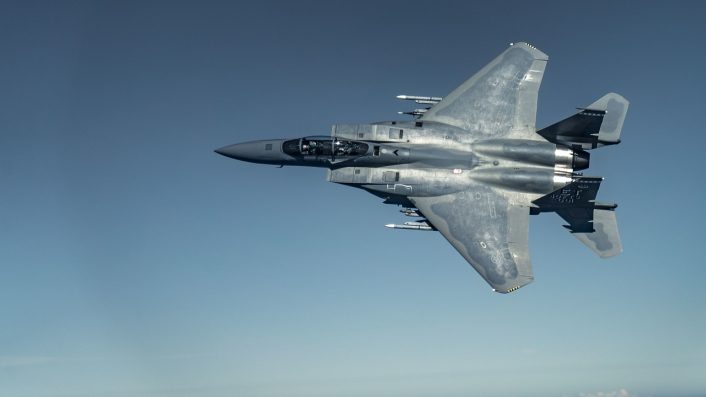
EPAWSS is fully integrated with radar warning, geo-location and increased chaff and flare capability to detect and defeat surface and airborne threats in signal-dense and highly contested environments. The system is currently not integrated with the AN/AAR-57A(V) Common Missile Warning System (CMWS) designed to detect infrared threats, even if the F-15EX features the same mounting points used for these sensors on the F-15QA and F-15SA.
Chaff and flares capacity has been increased by 50%, with four more dispensers added in the EPAWSS fairings behind the tail fins (two for each fairing), for a total of 12 dispenser housing 360 cartridges. This improvement is important as in modern scenarios chaff and flares are often released preemptively to counter MANPADS (Man Portable Air Defense System), meaning that now the Eagle will have more countermeasures available for a better protection.
EPAWSS also integrates cognitive electronic warfare to better discriminate the signals received by the system. This capability was demonstrated during the Northern Edge 2023 large force exercise test event, which tested EPAWSS’ ability to rapidly respond to previously unencountered electromagnetic threats. The tests challenged the system’s ability to process in-mission sensor data, create exquisite techniques, and optimize waveforms in real time.
As for the kinetic capabilities, the F-15EX can carry the AGM-88 HARM on outboard wing stations 1 and 9. This capability is reportedly a product of the fly-by-wire upgrade funded by the Royal Saudi Air Force during the development of the F-15SA.
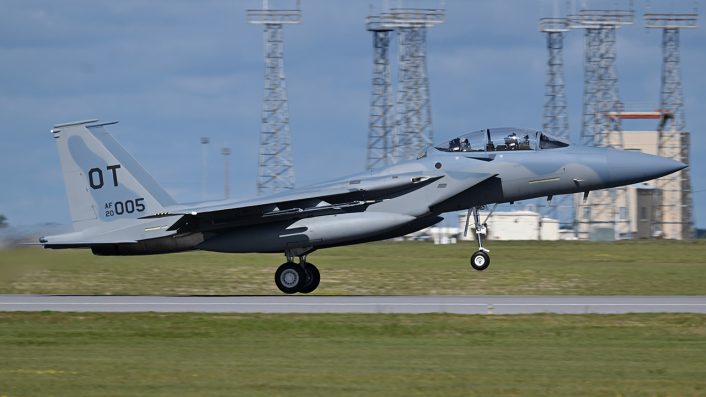
The EA-18G and the capabilities it could pass to the F-15EX
Based off of the F/A-18F, the Growler is a highly specialized Electronic Attack variant of the Super Hornet. The most noticeable difference with the baseline SH is the presence of the wingtip pods housing the ALQ-218 signals receiver suite, which helps to detect and geolocate emitters and signals.
The AN/ALQ-218 is a high performance RWR/ESM/ELINT system that allows the aircraft collect data about sources of radio frequency (RF) emissions: with this sensor, the EA-18G can “sniff” hostile radio signals to update the EOB (Electronic Order of Battle) of the combat theater where the aircraft is employed.
The EA-18G is equipped with an airborne electronic attack (AEA) avionics suite that has evolved from the EA-6B’s Improved Capability III (ICAP III) AEA system. In the future, with the Block II Growler upgrade and the NGJ (Next Generation Jamming) pods, the Growlers will also have Cyber Attack capabilities that will allow the EA-18Gs to “hack” or inject malware into enemy network.
The NGJ program aims to give the EA-18G fleet advanced airborne electronic attack capabilities through three frequency-focused increments – high-band, mid-band and low-band: in other words, the Growlers will replace the TJS pods operating in the 509 MHz to 18 GHz waveband, using three different pods, designated NGJ-LB (also known as Block/Increment 2), NGJ-MB (Capability Block/Increment 1), and NGJ-HB (Block/Increment 3) and directed specifically against the low- (100 MHz to 2 GHz waveband), mid- (2 GHz to 6 GHz), and high-band (6 GHz to 18 GHz) sections of the overall threat spectrum.
NGJ-MB is a high-capacity and power airborne electronic attack weapon system designed for the EA-18G electronic attack aircraft that was designed to carry out the usual job of denying, degrading and disrupting threat radars and communication devices, from an extended range and with enhanced ability than the previous AN/ALQ-99 tactical jamming pods, developed for the EA-6B Prowler.
The NGJ-MB, also known as the AN/ALQ-249(V)1 pod, uses directional emitters and AESA (active electronically scanned array) technology and an all-digital back end. It also has digital and software-based tech embedded in the design, which increases the ability to jam and allows for rapid beam steering and advanced jammer modulation.
While the NGJ-MB pod will “cover the majority of critical threats”, NGJ-LB will be extremely important to provide cover to stealth aircraft, threatened by the emerging counter-stealth Low Band radars, engaging enemy threats from increased stand-off distances and employing increased capacity (number of jamming assignments).
The Growler is also capable of carrying the HARM (High speed Anti-Radiation Missile) and AARGM (Advanced Anti-Radiation Guided Missile); these weapons are designed to seek out threat weapons systems and emitters, guiding on their energy, and destroy them. However, the EA-18G is expected to integrate also the new AARGM-ER.
The AARGM-ER is the evolution of the latest variant of the AGM-88 HARM (High-Speed Anti-Radiation Missile), the AGM-88E AARGM, a medium-range air-to-ground missile employed for Suppression and/or Destruction of Enemy Air Defenses (SEAD/DEAD). The AGM-88E is the result of a cooperative program with the Italian Air Force started in 2005 and developed as an upgrade and compliment to the AGM-88B/C. The AARGM program designed and produced a new Guidance Section and modified the existing Control Section, which are coupled with the legacy HARM Rocket Motor and Warhead Section, wings and fins.
The new Guidance Section features a passive anti-radiation homing receiver, satellite and inertial navigation system and a millimeter wave radar for terminal guidance, with the added ability to send images of the target via a satellite link before impact. The purpose of these new Guidance Section is to improve the effectiveness of the legacy HARM, especially against enemy radar and communications sites that would shut down to confuse incoming anti-radiation missiles (counter-shutdown capability) or pop-up threats.
As stated by the U.S. Navy, AARGM baseline capabilities include an expanded target set, counter-shutdown capability, advanced signals processing for improved detection and locating, geographic specificity providing aircrew the opportunity to define missile-impact zones and impact-avoidance zones, and a weapon impact-assessment broadcast capability providing for battle damage assessment cueing.
The AARGM-ER builds up on these capabilities to obtain an even more advanced weapon that is being integrated on the F/A-18E/F Super Hornet and EA-18G Growler and it is compatible for a future integration on all the variants of the F-35 Lightning II. The AARGM-ER combines the Guidance Section and Control Section of the AGM-88E with a new, larger rocket motor and a new warhead. The control surfaces have been redesigned too, obtaining aerodynamic strakes along the sides for increased lift and low-drag tail surfaces. The missile will reportedly have roughly double the range and speed of the AGM-88E.

